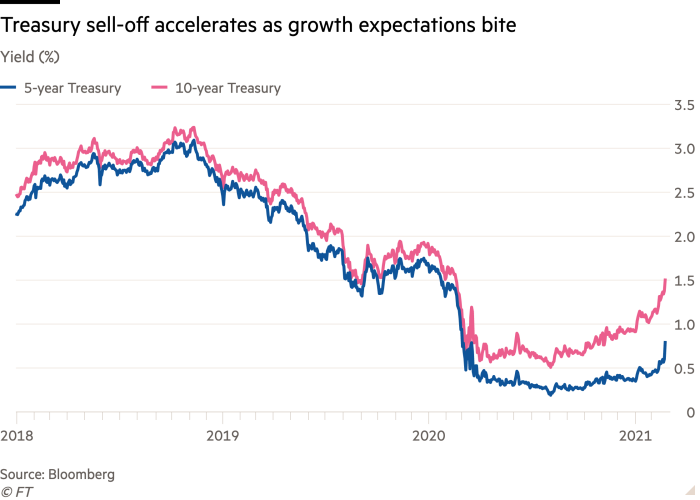A sell-off in US government bonds ricocheted through markets on Thursday, sending share prices lower and handing tech stocks their worst day since October.
The yield on the benchmark 10-year Treasury rose as much as 0.23 percentage points to exceed 1.5 per cent for the first time in a year. The five-year yield, which is considered to be more sensitive to monetary policy shifts, jumped 0.21 points to 0.82 per cent, the second-largest one-day rise in the past decade.
The sell-off in the bond market jolted equities, pushing the broad S&P 500 down 2.5 per cent. The tech-heavy Nasdaq Composite closed 3.5 per cent lower, its worst day since late October.
This week’s moves in the government bond market underscore how investors anticipate the flood of stimulus measures from the Federal Reserve and US Congress will lead to a rapid rebound in economic growth.
The brisk rise in yields caught many fund managers on the back-foot, with trend-following hedge funds and traditional buyers of mortgage bonds rushing to gird themselves this week. Their moves have exacerbated the global sell-off, traders said.

Shares in fast-growing tech companies have suffered some of the heaviest fallout, since their elevated valuations have been underpinned by low rates.
“Once the velocity of the bond sell-off picked up, everything had to be re-evaluated,” said Brian Bost, co-head of equity derivatives trading in Americas for Barclays. “It is why the traditional growth momentum trade, probably the most crowded trade in the world, has been taking it on the chin. There’s no doubt right now that rates are driving the market.”
The US Treasury tapped bond investors in the midst of the market turmoil, borrowing $62bn through new seven-year notes. But investor demand was lacking, with the bid-to-cover ratio hitting its lowest level since at least 2009, according to Bloomberg data.

“The intermediate area of the curve has undergone a truly violent sell-off over the last two days and the auction results suggest no one has the stomach to try and step in to turn the tide,” said Thomas Simons, a money market economist at Jefferies.
“This rate move has caught a lot of these accounts off guard,” Tom di Galoma, a managing director at Seaport Global Holdings, said, referring to hedge funds and buyers of mortgage-backed securities.
“We’ve had a sell-off globally. Australia, New Zealand, Canada, and most of Europe have all felt this pain. But I think it is coming mostly from hedging. I don’t think there are people bailing on positions.”
Market-based measures of inflation expectations rose rapidly in the wake of the US election in November and further still after Democrats took control of both chambers of Congress. However, this week’s jump in Treasury yields has come as these expectations have levelled off.
But implied rates on fed fund futures have steadily risen from zero, indicating some investors are positioning for the possibility the US central bank will lift rates sooner than previously thought.
The US Treasuries sell-off followed ructions in the Australasia government debt markets overnight, where the yield on Australia’s 10-year note raced 0.13 percentage points higher to 1.86 per cent.
New Zealand’s benchmark bond yield soared 0.15 percentage points to about 2 per cent, following a statement by finance minister Grant Robertson that the Reserve Bank of New Zealand should take overheating house prices into account when setting interest rates.
“Investors viewed this change as restricting the RBNZ’s ability to continue with ultra-easy monetary policy,” said Chris Scicluna, an economist at Daiwa.
European debt was also caught up in the wave of selling, despite some analysts arguing this was not justified.
Germany’s 10-year Bund yield added 0.07 percentage points to minus 0.23 per cent while the yield on the equivalent UK gilt jumped 0.05 percentage points to just under 0.8 per cent.
“Some of this [selling is] indiscriminate,” said Juliette Cohen, strategist at CPR Asset Management. “The gap between US and German bonds should be wider.
“The situation in Europe, where we have a delayed vaccination process and the reopening of economies is going to be more gradual, means there are fewer inflationary pressures than in the US.”
Cohen added that the “surprisingly rapid” run-up in Treasury yields, which inform what investors are willing to pay for companies’ shares, “has made us cautious on US equities, where valuations are tight”.







Leave a Reply